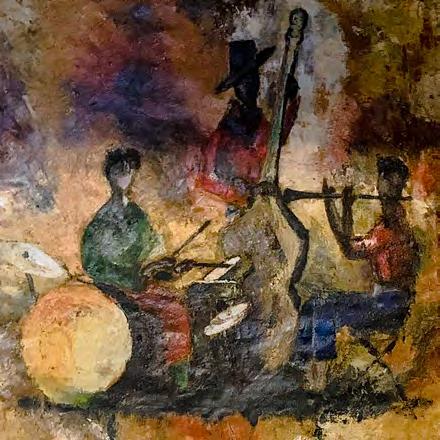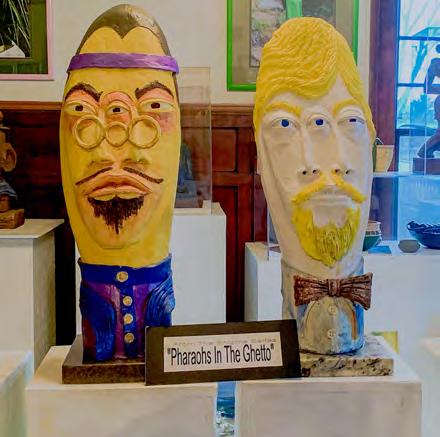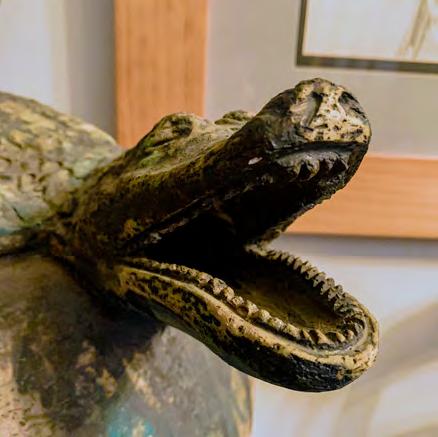
5 minute read
Master Artist Edward Everett Parker & The EEP Arts Complex
Master Artist Edward Everett Parker and the EEP Arts Complex
WRITTEN BY Tyisha Blade
Advertisement
PHOTOGRAPHED BY Max Torres
A museum of art in East Cleveland showcases work done by master artist and students
Take a ride up Euclid headed through Uptown and you will soon find East Cleveland. Go a little further, just beyond the border and you will find The Edward E. Parker (EEP) Arts Complex. Nestled on the corner of Rosalind and Euclid Ave., East Cleveland’s museum of art was established by Master Artist Edward E. Parker founder and retired professor of art. After years of rehabilitation, the complex now has an event center, art gallery, hair salon, classroom space, meeting rooms and apartments ideal for college students.
A Pennsylvania native born in 1941, Parker relocated to Toledo with his family where he studied at the Toledo Museum of Art. Parker recalls starting his love of art in elementary school where he attended Lincoln Elementary School. He graduated from Scott High School then earned his bachelor’s degree in art from Central State University in Art Education Administration. Continuing his education, he studied for his master’s degree in Art Education at Kent State University. A skilled and cultured artist, Parker has also studied across the world in countries such as Africa, Mexico and Ecuador. Since then, the master artist has sustained a life of work in arts and art education. As an educator, Parker taught and worked in the Cleveland Metropolitan School District as the head of the art department at Audubon Jr. High for several years. He later taught at Cuyahoga Community College’s western campus for 20 years as a professor of art and the arts department coordinator.

At the age of 42, wanting to expand from his first gallery in the Buckeye area, Parker found an abandoned building that had been vacant for nearly two decades. Parker bought the East Cleveland building, formally a Cleveland Clinic nursing facility, in 1984. “I walked in [the building] and there were feces, racoons, skunks and possums everywhere, ” he said. “So, I started working.” He and a friend began the process of fixing the building and cleaning it out. Since then, he has developed several displays of art in his gallery that not only include exhibits of his creativity, but also show the relationship between art and society. For example, the sculpture Reflections of the First Year of Two Lovers is a vertical series of sculptures that show different dynamics in the first year of a relationship. “At the top they copulate,” he said. Another piece Parker created is Pharaohs of the Ghetto featuring African, European, Asian and Indian pharaohs. “All people have a pharoah,” Parker said. “No matter what culture it is, there’s always a pharaoh.” Other works featured in the gallery are Daughter of the Sun, Daniel and the Lion’s Den, Get This Monkey Off My Back and The Full-figured Woman Series.
Parker has several art projects throughout the East Cleveland city including a billboard on Superior and Terrace and a mural at East Cleveland’s Martin Luther King Jr. Civic Center. If you’ve ever driven up the East Cleveland side street, Rosalind, you will notice two mansion-sized columns on each side of the street--both designed by Parker. Much of his inspiration comes from people that he meets and sees. A “theme artist,” some of his works include sculptures of Chicken George, Malcom X, Micheal Jackson, Paul Worfield and more. He continues to work and has recently been commissioned to begin another project with the Civic Center.
Parker also offers art classes at the complex where students use sculpting techniques to build busts, two-part molds and other pieces that Parker displays

at the complex. Two of Parker’s students, grandmother Vanetta Neal and granddaughter Alicia Neal, frequent the classes and enjoy the learning as much as they do sculpting. “[My grandmother] invited me and I was like ‘Yea, I’ll go,’”Alicia said. “I like how expressive [art] is. There’s no limits or rules, you just do what you want and have fun with it.” Vanetta goes to the class every week said she enjoys everything about it. “It’s really relaxing, and this is my outlet,” Vanetta said. “[Parker] is an excellent teacher and he brings out the best in us. He fusses at you, but teaches and tells you exactly what you need to know.” Akhi Knightan, another student in Parker’s class, studies Art at Tri-C Eastern campus. After some encouragement from her mentor, Lady Palmer, to pursue Art, she began attending the class. “I wanted to learn, and I have been here ever since,” said Knightan. “I am really enjoying the classes and learning and [the classes here] help me with my classes at Tri-C.” Art classes are every Tuesday and Thursday from 6 p.m. to 8 p.m. and senior citizens attend for free. Parker offers a discount for groups of 10 or more. He also has an African Bookshelf & Gift Shop which is filled with Black Children’s Books and African Masks. Located directly next door to the complex is Parker’s Guest House, a bed and breakfast—fully furnished with three bedrooms, a jacuzzi, a laundry facility and a sauna. Parker also hosts the Annual Collard Greens Cook-Off and festival in September in the venue’s spacious backyard.
His list of accomplishments doesn’t end with his work in art and education. Parker has been recognized and honored across multiple prestigious platforms. For instance, he has received awards of appreciation from the East Cleveland Public Library for his service on the board of trustees. He has been featured in The History Makers. He has also been honored with an award of appreciation by the East Cleveland Board of Education as well as a Power Networker of the Year award. Parker is featured in publications such as the Plain Dealer and The Collective Arts Network. He sold his work all over the world, but currently hopes to keep his remaining work in the museum. He wants to leave his legacy to a university or other museum of art. “I might give it to them for free if they can keep my museum alive,” he said. Parker encourages locals to visit the complex. “People need to get over here and see what is happening in their neighborhood,” he added. For more information on The Edward E. Parker Art Complex, visit www.eepmoa.com.





